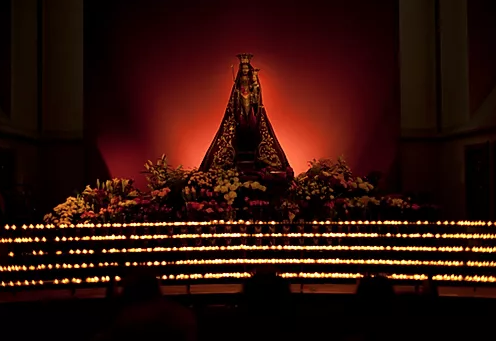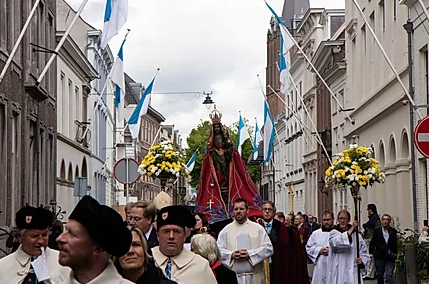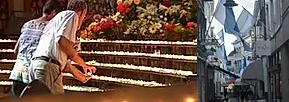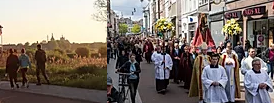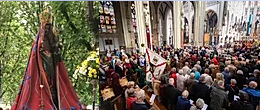Start
The Gentle (in dutch i.e. “Zoete” = Sweet) Mother or Gentle Lady of the city of ‘s-Hertogenbosch/Den Bosch is one of the mercy statues of Mary in The Netherlands. It is a main center point of a pilgrimage. Since 1380, Mary of ‘s-Hertogenbosch/Den Bosch is being honored in St. John’s Cathedral of the town. The Holy Mother statue worship is unique because her lack of appeal is the reason for her worship.
Legend
According to legend, in January 1380, the neglected statue was discovered during the building of the Cathedral. It was found between a stack of shelves by a young worker at the cathedral who was looking for firewood. When he started to chop the statue into pieces, he was prevented from doing so by his boss who saw that it was an old statue of Mary. On “Holy Thursday” the worker placed the statue of Mary near the altar before the body of Christ. When this altar and surrounding chapel area were cleared the next day, the old statue remained alone. A monk, brother Wout, brought the statue to the altar of Saint Michel in one of the radial chapels behind the presbytery. The canon who was there reading mass every day took the Statue away after a short time, and brother Wout asked the canon if he was allowed to take the statue elsewhere. However, it had- all of a sudden – become very heavy. Than it was to be placed in the Mary Chapel, invisible behind an altar. Brother Wout arranged a little cloak, and again recovered the part of the statue of the child Jesus located outside the Church.
In the Summer of 1381, he placed the statue of Mary at the altar of the Holy Martin, where people actually made fun of it. A female passer-by stopped and mocked the statue finding it ugly and that next night, Mary appeared to her and asked “why do you say that I’m ugly? I am in eternal life, which is clean, in the highest of heaven! I recommend you so, that you come to me for your retreat, to overcome your suffering and to obtain eternal life.” The woman then asked a noble Lady the next day in church to have the statue decorated.
Healings
A little while later, a crippled woman named Hadewich van Vichten had been cured after an appearance of Christ who had advised her to go for the Blessed Virgin of the decrepit image to say grace for her intercession. This miracle was the first of a long series of miracles and healings. Almost 500 miracles were recorded in the miracle book called “miracles of our Lady from ‘s-Hertogenbosch” from the time period of 1381-1603.
Miracles were written down in the Cathedral and people came from pilgrimages far and wide telling of Mary to the churchgoers about their wonderful experiences concerning the Sweet Mother of Den Bosch. The book was (and still is) available to see in Mary’s chapel and includes stories of pilgrims of places in the present Netherlands and far beyond, such as Danzig (Gdansk in today’s Poland), Aachen, Kingmountain in Prussia, Bremen, Kleve, Emmerich (Germany), Mechelen, Leuven, Brussels, Bruges, Antwerp (Belgium), Amsterdam, Haarlem, Groningen, Gouda, Delft, Utrecht, Maastricht, Zierikzee, Zaltbommel, Harlingen and Kampen (The Netherlands). And, of course, the city of s-Hertogenbosch itself with nearby villages such as Den Dungen, Oisterwijk and Sint Oedenrode. Pilgrims reported miracles and unexplained healings that occurred as a result of Marian intercession. Mary appeared in dreams to believers to go to ‘s-Hertogenbosch on pilgrimage for medical healings and even wonders including reported possible resurrections from death!
The statue of “Sweet Dear Lady” or “Sweet mother” and prominence
After the start of the miracles in 1380, for the first time, the ‘ ugly ‘ image was seriously restored to its current appearance. It became so famous that the money/alms of the visiting pilgrims made also the construction of the present Cathedral possible. Nobles and princes, including Philip II, Emperor Maximilian of Austria, Dukes of Brabant/Gelre and Parma, Philip the fair, Charles V, Albertus by Austria, Erasmus, the honorable Leonardus van Veghel, Saint Peter Canisius all came here in pilgrimage. They have all visited the Sweet Mother kneeling and in prayers. But, still, first of all, it was the chapel of the “sweet Mother” as it was called, a home and haven for simple ‘Bosch’ people.
Iconoclastic and reformation
On August 22, 1566, the start of the protestant times in Europe, ‘s-Hertogenbosch was struck and the Statue of the Sweet Mother was placed in safety in the city Hall on the Market Square. Later on the Statue of the Sweet Mother was placed back in the Chapel. In 1629, the city fell during the 80-years war (1578-1648) and ultimately into the hands of the Protestants, which wanted the statue to be burned with all the other images of Saint John’s cathedral. Two Carmelites brought the Sweet Mother to the Bishop, however, on his return also brought the statue safely to Anna van Hambroeck, a Catholic woman of noble birth, who was related to the new Governor. Anna smuggled the statue to the city of Antwerp, and later, at the request of Archduchess Isabella of Spain, daughter of King Philip the second of Spain, brought the statue over to Brussels after the permission of the Bishop of the Diocese of ”s-Hertogenbosch (Michael Ophovius) under the absolute condition that this city would NOT regard it as its property, but would return the statue to the Diocese of ’s-Hertogenbosch, and the city itself, once the Roman-Catholic faith there would be restored.
Brussels
In Brussels, the statue of the Sweet Mother was held in high honor, it was even carried in procession through the city each year, just like in ‘s-Hertogenbosch, an annual tradition until 1629. The people of Brussels were particularly attached to the Bosch Statue of Grace located in their church of Saint Jakob “on Coudenberg” where the statue was enthroned on an altar of stucco clouds. In the nineteenth century, with great effort, Den Bosch was able to get the statue of the Sweet Mother back. The Great Dutch Bishop Monsignor Zwijsen assisted with this and eventually accomplished this on December 27, 1853, on the feast of John the Evangelist (Patron Saint of St. John’s Cathedral). This was more than 40 years (!) after the liberation of the city and the allowed ability out of the government to celebrate the catholic services freely again in the Saint John’s cathedral.
General/the Sweet Mother nowadays
Mary, better known in town as the “Sweet Mother (dutch [Zoete Moeder]), is still visited all throughout the year by people from far and wide in the St. John’s Cathedral. The number of lit candles that are annually placed at the sweet Mother are lighted with the intention of a thought, prayer and/or a pilgrimage. Although the times of our 21st century in Europe are known by the dechristianisation of Europe, it is impressive that there are approximately some 400,000 candles at the site annually. This is especially noticed in the month of May when Mary, as mother of God, stands central in the Catholic faith by honoring Her as the “Mother of the Lord”. During this month, there are frequent pilgrimages from the Meierij (region to the East and South of Den Bosch), the Langstraat (region west of Den Bosch) and the Bommelerwaard (region in the dutch province of Gelderland to the North of Den Bosch). Hiking and cycling pilgrimages of 20 and 30 km and than going to one of the many Eucharistic celebrations in the Cathedral on Saturdays (12.30 hours)-, Sunday- and holidays (as well as Ascension and Pentecost falling in the month of May). This tradition remains traditionally popular with celebrations starting at 8.00 a.m. 10.00 a.m. and 12.00 a.m. The Cathedral is visited each weekend in May by thousands’ of pilgrims and parishioners. Many choirs, folklore and historical guilds complete the pilgrimage to the city of ’s-Hertogenbosch to participate in mass and pay their respects to Mary, as our “Sweet Mother”.
Route of the procession on mother’s day
On the second Sunday in May-worldwide known as mother’s day – the Maryprocession traditionally takes place with the route of the procession along with the statue of the Sweet Lady. This tradition has a remarkable history of development and experience.
After the restoration of the bishopric hierarchy in 1853 in the Netherlands annual processions with the sweet Mother were allowed to reappear in public life. The popularity was great, and in 1889 an estimated crowd of 15,000 to 20,000 participants did participate. The annual procession from 1916 was more festive in character and brought about a change into a more official procession. It became a procession with costumed participants containing historical and biblical scenes of Mary. The town of ’s-Hertogenbosch was more connected to its own predominantly catholic history. After the 1950s, the popularity increased. In 1967, it became a procession with a more sober character.
The procession in our days still takes place on the second Sunday in May (mother’s day) walking the old procession route with the Statue of the Sweet Mother. The believers accompany the statue of the Sweet Mother using the 14th century procession route, flanked by many blue-white (Marian) flags that are attached to the facades. This is planned after the Eucharist celebration of 11.45 a.m., which then starts about 13.00 p.m. . On one condition: only if the weather allows it. Since the statue of the Sweet Mother is vulnerable, there should be no rain predicted. This 14th century medieval pilgrimage has many beautiful Maria statues to the facades as well. According to the tradition along the route also little Mary statues are to be placed in the houses behind the (front) windows with sometimes burning candles. Together with blue-and-white flags (mary colours) and bouquets of white and yellow daisy’s (the catholic colours) which are usually found on display.
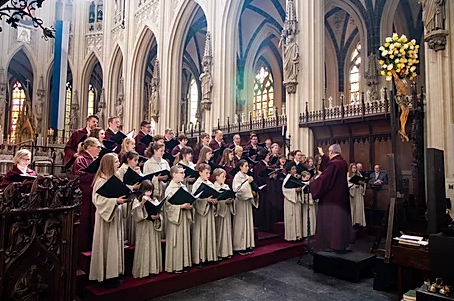

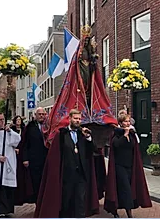
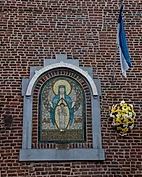
Processionroute
The Procession route goes along the streets and houses in town, where, according to the tradition, the Sweet Lady of Den Bosch would have walked in the 14th century, also at the time of a major outbreak of the plague. Initially, on the day preceding her journey, the tradition outlines, a procession was planned to ask her intercession for salvation and healing of the many plague sufferers. Because of the very bad weather on the day of the original procession, the procession was postponed. Than, it was discovered that in the early morning on the next day, they found the miraculous statue of Mary in the middle of the Church standing with smeared undergarment. This turned out (later that day) to be a miraculous cure of plague sufferers along the houses of the inner-city streets where in our days still the maryprocession route is being marked/walked in the city center. Both on mother’s day in the month of May as during the Mary Novena of Den Bosch (a nine day prayers tradition) of the sweet Lady starting on July 7, her feast day lasts until 15 July.
Tradition of the Bossche Mary Novena
The actual tradition of the actual Bossche Maria Novena (7-15 July) has been ‘officially”in existence since 1866. 1866 was the year that the city suffered from the illness of cholera. In that year, an “extra loop” at the 14th century pilgrimage joined the route of the 14th century one which was nearby the “Mary Chapel in the Spoonstreet (dutch: Lepelstraat) so called “Association of the praying Marymen”. It was the year that the gathering of people in the St. Johns was forbidden by the ecclesiastical authorities because of the risk of infection of cholera. This Chapel was only big enough (in the walking route) to stop nearby for prayers and lighting candles.
Walking the old pilgrimage in Novena tradition was, however, an older tradition that in fact goes back longer than 1966. I.e. to approximately 1629! After the capture of the city by Frederic Henry in september 1629, the catholic faith was forbidden to practising. From 1629 to 1810, no public processions and religious (Catholic) rituals were allowed. The State reformed religion (the accepted Protestantism) was for the religious life in the city in that period the only official one. In, May, 1810, the cathedral was returned to Catholics by Napoleon Bonaparte. Before 1810, the catholic faith had to go underground and stayed alive because of many secret churches which secretly were decorated in living rooms. Priests were, at that time, secretly smuggled into the city. With the sudden change of the religious wind and quickly arranged departure of the image of the sweet Mother to Brussels in september 1629, the Catholic people in town developed the use of a quiet silence prayer tradition by walking quietly (silently to themselves praying) the famous (middle-ages known) streets of the pilgrimage during 9 days. This was done, often in the evenings as an individual person or in pairs, not in groups. This could else (probably) lead to problems that would provoke the protestant City Government of those days than.
Mary Chapel St. John’s Cathedral in the 21st century
Except for the month of May, you will find the Sweet Mother in her private chapel on the north side of the St. John’s Cathedral, traditionally in a sea of flowers and hundreds of burning candles. Many local residents, tourists and other visitors honor Mary weekly with flowers and pray for intercession and/or light candles. On the walls of the chapel approximately, 1100 ex votos have been placed which are gifts that serve to thank Mary for healing, consolation or prayer. These gifts are usually in large painting-like formats. All of these objects are gifts from pilgrims (from the 19th, 20th and 21st century) who wanted to thank Mary for her intercession for support in prayer, healing and/or encouragement. Unfortunately, the extraordinary stories behind these gifts have not been recorded such as those of the old medieval miracle book, although a lot specific things are known by the silver gifts that were given as ex-votos. What is known in the cathedral nowadays is, who has done this with the description of the donation (for example, a silver leg or silver heart). For the sake of privacy, however, the data, are not available, due to European privacy laws.
